INNOVATIVE TRADITIONAL EARTH MATERIALS AND TECHNIQUES
Info: 7973 words (32 pages) Dissertation
Published: 9th Mar 2021
BUILDING UP THE FUTURE WITH INNOVATIVE TRADITIONAL EARTH MATERIALS AND TECHNIQUES
ABSTACT
Industrial revolution has made the traditional materials been routinely unnoticed due to their unpredictability as more reliable, industrially produced materials become widely available. Many traditional materials shows a revival in several countries due to several growing concerns like nontoxic building materials and climate change. My first serious of encounter of the use of natural materials during the year 2010, when as an undergraduate architectural students. I undertook a study of each traditional building materials of each different countries, until that my awareness was limited by lack of knowledge and understanding. All the building materials which is innovative at first becomes traditional when it is used as over a considerable period of year in similar ways. As an international material earth provides the ultimate green construction substance. In today’s Scenario these remains a considerable amount of professional misunderstanding and ignore of the materials and so many other traditional construction techniques are currently in the process of having much to relearn what it was once familiar. Many assumes that earthen architecture will be is in rural areas, but there are examples of building made of earth like offices, institutions, etc… Earth buildings are through as pre-modern or backward. The guidance from the subject expert and drawings, explains this report with the beauty and simplicity of ones of human kinds most evolved and sophisticated building technology. It is an approach for a great simplification of what was an infinity variable use of material around the country. Through relearning and from analysing emerging faults and the techniques used in the undertaking the building and repair work it is anticipated that eventually be able to offer great understanding and awareness of the traditional skills are required to effectively work with various mixes. The current scenario shows the world is more sensitivity in developing the concept of sustainable development that encourages the awareness and increases of using locally available material for both housing purpose and as single components
Content..
Overview
Introduction
Aim
Research Questions
Objectives
Scope of the study
History
-Millennia old tradition
-Regional historical context
-Geology, climate, topography
The Earth- as material
-The properties of Earth as a Building material
– Transitional point
Traditional Materials – Scotland
-List of traditional materials
Earth Construction
– Materials and Techniques
Case Studies
Earth Materials and building procurement
Research Answers
Conclusion
SUMMARY OF THE CHAPTER
–
- This chapter explains the overview of the entire report starting with the brief introduction of the topic next stating the aim of the study, the research questions to make the clear view of the study, objectives of the study and scope of the study
CHAPTER-2
- The second chapter deals with the historical context of the location, and the story of traditional materials used worldwide and regional context of Scotland, this chapter also speaks about the climate, topography and geology of Scotland it explains the birth location and availability of materials. .
CHAPTER-3
- The third chapter is discussing about the properties of Earth as a building material, how each material is selected for building and based on what criteria?, and how the materials are used in the areas of Scotland, also deals with the advancement and stages of transformation of materials.
CHAPTER- 4
- CASE STUDY
CHAPTER-
INTRODUCTION
“Here for years, for centuries, the peasant had wisely and quietly exploited the oblivious building modern school-learned ideas, never dreamed of using such a ludicrous substance as mud for so serious a creation as a house. But why not? Certainly the peasant’s house might be cramped, dark dirty, and inconvenient, but this is no fault of the mud brick. There was nothing that could not be put right by good design and broom.” – (Hasan Fathy, 1937)
- HASSAN FATHY
 The oldest building material used by man was “EARTH” in some form. This study is particularly focusing on the advancement of earth construction happened in last few years. It is providing the new creative ideas and application of traditional materials on the planet. Many experts are researching on traditional techniques to create a good development in the applications of modern construction. There are endless possibilities and advantages in using the earth materials.
The oldest building material used by man was “EARTH” in some form. This study is particularly focusing on the advancement of earth construction happened in last few years. It is providing the new creative ideas and application of traditional materials on the planet. Many experts are researching on traditional techniques to create a good development in the applications of modern construction. There are endless possibilities and advantages in using the earth materials.
The new found ambition is to, the reestablishment of local materials with cultural connection of collaboration and knowledge transfer shows the advancement of the construction methods, and even new building materials and products have been realized by stimulating the evolution of traditional materials and its methods. The positive development can have wide reaching effect from public perception of the materials to promoting larger scale production and use. The research further speaks about the advancement of traditional material and its techniques according to 21st century, there by saying from old and outdated into current and progressive. Unfortunately in the present world so many of us think the proper building can be built only by reinforced concrete, cement blocks, burnt bricks etc… But the fact is the manufacture of steel and cement for reinforced concrete is called as “Energy intensive “.It needs very less technology, easily available materials, economically cheap and strong quality.
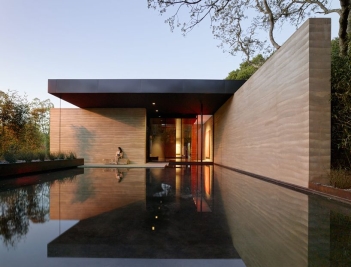 This paper shows that traditional materials may be old fashioned but the plus point of the materials is it has been tested and used for thousands of years, but the concrete has been in circulation for less than two hundred years. These modern materials can be successfully used for the best houses , indeed in 21st century with a roof cover over a 800-900 million heads, we will only be able to if we bring back the traditional materials into its rightful status. In next fifty years the major problem is, will create a demand in energy fuel power. This can be solved slowly by encouraging and make use of energy free materials. Each traditional and vernacular material has its own advantages and limitations. Earth construction are the one of the most interesting technologies. . Mud besides its being merciful and cheap, it is undeniably beautiful: those structure explains the form and the material impose the scale. Within the limits imposed by resistance of mud and the law of statistics, it brings out the freedom to shape , space within the building that enclose the volume of chaotic air, and bring it down to order and gives a meaning to the scale of human being.
This paper shows that traditional materials may be old fashioned but the plus point of the materials is it has been tested and used for thousands of years, but the concrete has been in circulation for less than two hundred years. These modern materials can be successfully used for the best houses , indeed in 21st century with a roof cover over a 800-900 million heads, we will only be able to if we bring back the traditional materials into its rightful status. In next fifty years the major problem is, will create a demand in energy fuel power. This can be solved slowly by encouraging and make use of energy free materials. Each traditional and vernacular material has its own advantages and limitations. Earth construction are the one of the most interesting technologies. . Mud besides its being merciful and cheap, it is undeniably beautiful: those structure explains the form and the material impose the scale. Within the limits imposed by resistance of mud and the law of statistics, it brings out the freedom to shape , space within the building that enclose the volume of chaotic air, and bring it down to order and gives a meaning to the scale of human being.
“The windhover Contemplative centre” @ Stanford University
Particular Dirt on the site was too dark it created a rich background for the “art=building “, the builder blended the site soil with other materials and achieved beautifully with contemporary design.
AIM
My aim of the dissertation to make a study of modern use of ancient building blocks play a significant role in the upcoming future.
RESEARCH QUESTIONS
Express the problems with the techniques as why they make earth architecture is objectionable for present?
By bringing up Mixing old and New- what are the Benefits and challenges going with the traditional materials when integrated with modern world. ?
OBJECTIVES

 The objective of the study is to present the general characteristics, properties and ideology of materials and its interesting construction technologies. This study also deeply speaks about the advantages and disadvantages of materials performance based on the important factors such as geography, climate, and craftsmanship. The significant ecological properties of the materials and its environmental benefits. Analysing various earth construction techniques and bring up with the innovative ideas for the present scenario.
The objective of the study is to present the general characteristics, properties and ideology of materials and its interesting construction technologies. This study also deeply speaks about the advantages and disadvantages of materials performance based on the important factors such as geography, climate, and craftsmanship. The significant ecological properties of the materials and its environmental benefits. Analysing various earth construction techniques and bring up with the innovative ideas for the present scenario.
SCOPE OF THE STUDY
TheEarth is currently widely used in construction as primarily materials such as aggregates, sands and minerals and as fired clays. The high level of processing of materials is the current practice involved in the construction technique. This report focused on the low processed forms of earth materials which investigates traditional techniques that have been successfully used in the UK, in context relevance to the Scottish traditional methods including factors like climate, technique or cultural reason…the report also evaluates in Scotland how the heritage of the earth construction technique in context with the Modern European revival and inspect how the earth is going to be related with modern Scottish construction industry and widely showcasing the opportunities for the new development. The main scope of the study clearly shows that to secure the traditional construction technologies and apply on the buildings with innovative ideas for the benefits of future and the environment. The study limited to the Scottish patterns in highland buildings.
MUD( WET AND SOFT EARTH)
RAW
PROCESSED
IN CONTEMPORARY ARCHITECTURE
HAMLETS
VILLAGES
PROCESS,
TECHNOLOGIES,
TECHNIQUES,
ALTERATIONS,
ADDITIONS
ASPECTS OF EARTH ARCHITECTURE
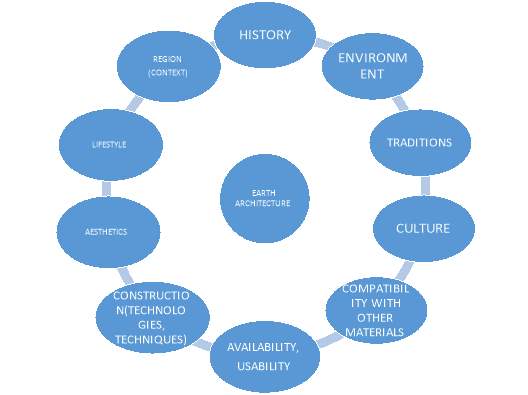
WHOLE (RESORTS, BUNGLOWS, HOUSING, INSTITUTION)
PART (INTERIORS, RESTORATION

 CHAPTER 2
CHAPTER 2
HISTORY
![Half of Humanity lives in Earth construction [2]Â](https://images.ukdissertations.com/33/0361745.007.jpg)
A) MILLENNIE OLD TRADITION
Down through the ages, people have been using raw materials to build their living space. Each and every continent and country showcases the rich heritage constructed with earth materials. From the roof of the world in Tibet or the Andes Mountain in Peru to the Nile’s shore in the Egypt or the fertile valley of the china, there are many examples build with earth as a building material. In Russia many Earth construction technique was known over 9000 yrs., and many mud brick (adobe) houses dating from 8000 to 6000 BC have been discovered .(Pumpelly, 1908).
 Rammed earth foundation dating from ca.5000 BC have been discovered in Assyria. In ancient culture earth is not only used for building homes but also for the religious structures too. At Gourna the temple of Ramses II vault structure was built with earth materials was one of the finest example. Egypt was used mud brick as a primary source of material to build. The citadel of BAM in Iran parts of them are 250 years old. The Great Wall of China was 4000 years old it was originally built with rammed earth later on stones and bricks added as alter coverings that appears like stone wall. In Teotihuacan, Mexico, between the 300 and 900 AD, the core of the sun pyramid was built with earth material that consist of two million tons of Rammed earth in it. The earthen building still stands around 3300 years is the world’s oldest one. In India the oldest earthen building is tabo monastery in Spiti valley- Himachal Pradesh. This was built with Adobe and it has withstand the Himalaya winter since 996 AD.
Rammed earth foundation dating from ca.5000 BC have been discovered in Assyria. In ancient culture earth is not only used for building homes but also for the religious structures too. At Gourna the temple of Ramses II vault structure was built with earth materials was one of the finest example. Egypt was used mud brick as a primary source of material to build. The citadel of BAM in Iran parts of them are 250 years old. The Great Wall of China was 4000 years old it was originally built with rammed earth later on stones and bricks added as alter coverings that appears like stone wall. In Teotihuacan, Mexico, between the 300 and 900 AD, the core of the sun pyramid was built with earth material that consist of two million tons of Rammed earth in it. The earthen building still stands around 3300 years is the world’s oldest one. In India the oldest earthen building is tabo monastery in Spiti valley- Himachal Pradesh. This was built with Adobe and it has withstand the Himalaya winter since 996 AD.
A MILLENNIE OLD TRADITION
B) REGIONAL – HISTORICAL CONTEXT
This chapter will outline the historical basis for the Scottish earth building and also discuss the diversity of traditional techniques. The age of the enlightenment, the flowering of Scottish culture which had begun in the late eighteenth century was over and the eclecticism of Victorian age was ebbing. At the beginning of eighteenth century the Scottish houses building market started establishing themselves .The forward movement in agriculture technology allowed for larger areas to be maintained by the farm machinery and so villages for the workers were established, because of them no longer requiring to move around to and from temporary accommodation of the year round. This started creating a central point of amenity for the new villages. This new relationship of dwelling to each other also created a much great potential for the social interaction between families and it extended the creation of communities. In Britain the earliest house so far discovered was around 10,500years old. It was a site near Scarborough. It shows the settled domestic existence that can be identified for people leaving in British Isles. Building with timber occurred nearly in all areas, through traditions were naturally much stronger were woodland was plentiful. Sparsely wooded areas like the Scottish islands. Unavailingly they used timber more selectively .When the timber was not the primary structural material they required different methods for constructing walls. Building with earth or stone was the usual alternative preferred options, common approaches to construction exist across Britain but the locally available materials and the craft traditions involved in their use have shaped the character of regions and localities (Ngowi, 1997). Scotland has the long tradition of constructing the building with stone rather than wood despite had a vast virgin forest cover dating back to the period following the last ice age. The shortage of native timbers is reflected in the extensive seaborne importation of Baltic timber, now the traditional architecture in Scotland is largely based on the stone, being very heavy and considered of relatively low value was sourced locally in the first insistence (floyd, n.d.). The architectural style done with local materials based on the local needs reflects the local tradition is also known as vernacular style of architecture and it is used describe the minor buildings of town and country side , this term was used by architects, hi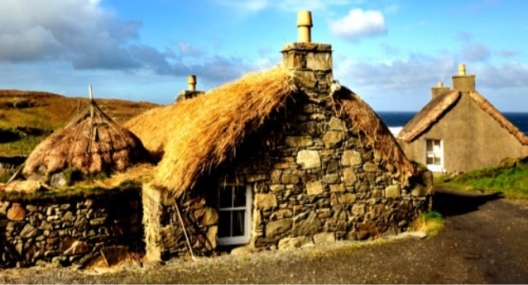 storians, archaeologists and critics .
storians, archaeologists and critics .
REGIONAL – HISTORICAL CONTEXT

Context Map of Scotland
BLACK HOUSE = Traditional type of house common in the highlands of Scotland
CLIMATE, TOPOGRAPHY AND GEOLOGY
As Scotland is touching the Arctic Circle, the gulf of stream it manages the temperature relatively mild all over the day. One of the most important significant influences on the traditional architecture is macro climate of the place where the building is constructed. Scotland has a very changeable climate which varies from minute to minute. For one minute the sun could be splitting the stones, but suddenly there will be a lashing rain on the next minute. In Scotland there is a varied variation in the climate is found in less distance throughout the day. It is totally different in highlands the weather can change to different extreme very quickly, in Scotland east coast tends to be cool and dry and the temperature rarely drops below the freezing point during winter period, in summer the temperature is around 19degree Celsius (66 degree Fahrenheit), it is lot milder and wetter on the west coast with the average of highest. In Scotland May and June considered as driest months, July and august considered as warmest months. In northern Scotland the sun barely sets and in winter months it hardly rises at all. There is a very close relationship between the traditional architecture style and building materials and local geology. The geology of southern Scotland region is dominated by a huge area of lower Palaeozoic Greywacke sandstones and siltstone. The study of geological map of region shows that there are many other interesting and alternative rock types, albeit of more restricted occurrence, many of them have been utilised in the built environment among the more it’s clear that the red sandstones of the Permian – Triassic basins at Dumfries, Lochmaben and Annan, the Devonian granites of Galloway and the red to buff Devonian and carboniferous sandstones and minor igneous rocks (both lavas and intrusions) of the border of the countries. This commonly results in the local geology being so deeply reflected in the vernacular architecture that as a geologist, one can almost easily locate oneself within that region by simply studying about the building stones which have been used in the farms, villages and towns of the surrounded area particularly in older structures. The varied topography and consequent science attraction is too well to require much comment. The rivers fed by melting snow of ice Ages and still it is sustained by locally high rainfall that have deposited silt to make delta as within the valleys. Man’s effort on the scenery has been mixed .Geology and topography stay close together. They consists of old hard slate granites. These are surrounded by a belt of carboniferous limestone reaching the sea of south. The eden valley consists of sandstone partly hard and pink but mainly soft brown Permian and triossic of Penrith and St.Bees. When the man made elements interact with the macro climate it determine the factors that affecting comfort in the built environment: Light, heat wind and humidity.
CLIMATE, TOPOGRAPHY AND
GEOLOGY
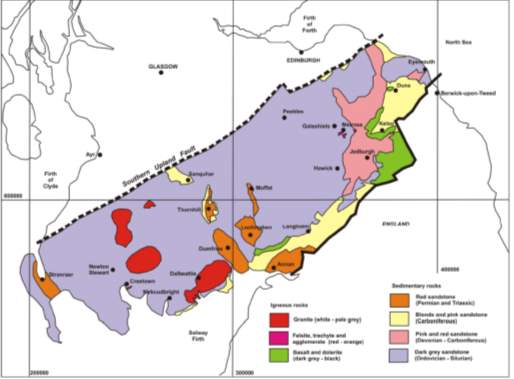
Simplified Geological map of south Scotland showing the principal rock types used for building stones.


CHAPTER-2
THE PROPERTIES OF EARTH AS A BUILDING MATERIAL
Earth comes from the disintegration of parent rock, this rock disintegrates into mineral particles with varying dimensions ranging from pebbles to clayey dust. There are various types of Earth according to size, quantity and the components are: Gravelly Earth – Sandy Earth – Silty Earth – Clayey Earth.
“Soil “can be formed in an infinite variety of composition and possess an endless variety of properties such as adhesion, cohesion, compatibility, bulk density, porosity, plasticity, capillarity, and liner and volumetric shrinkage, among others. Earth has been used as a construction material since ever because it is a low cost material Earth, it is available everywhere , recyclable, incombustible and within the construction it can be used in a wide variety of ways to build walls as load bearing and non –load bearing and other elements also like floor, roof, etc.. The material react to the environment and atmosphere surrounded it creates a proper thermal insulation with good ability to regulate the quality and the internal air humidity, this material naturally provides good acoustics as well. If properly used it is most durable and beautiful material. Among earth building techniques rammed earth is one of the important technique in traditional construction and modern earth architecture. According to Hammond (Hammond, 1973) ,explanation the deterioration of earth buildings are mainly due to Shrinkage, cracking, erosion, underscoring and mechanical damage, the fact is it is due to directly or indirectly of water. The earth buildings successfully last for decades in almost all types of region and climates and also with proper care and maintenance when it’s done with suitable architectural design, structural techniques and proper stabilization measures and a care in sitting. For all types of earth construction, the important properties are the compressive strength, water absorption and weather resistance.
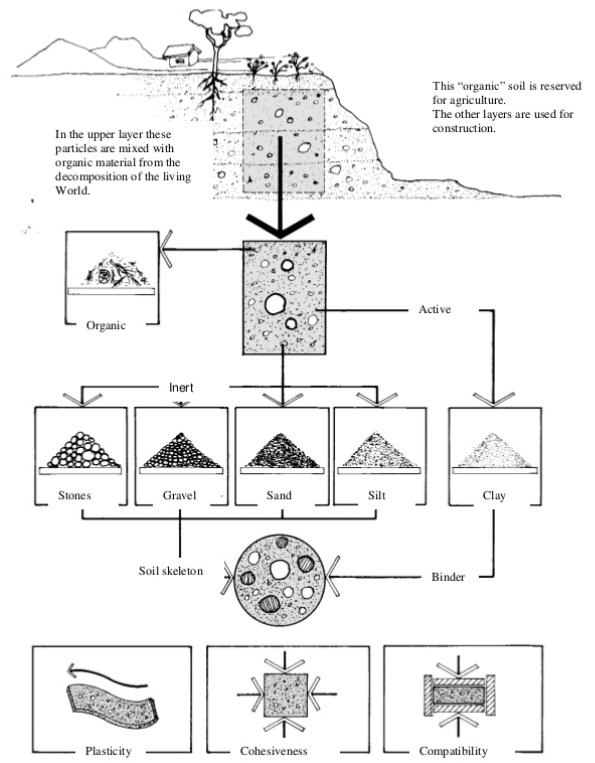 When compared to the many commonly used contemporary building material the production and construction of earth materials do not have any health hazard and no pollution.
When compared to the many commonly used contemporary building material the production and construction of earth materials do not have any health hazard and no pollution.
THE PROPERTIES OF EARTH AS A BUILDING MATERIAL
Strength- The earth has a good strength in comparison, when it is used in the building as a material but the important factor is it has less strength in tension, predominantly in damp state. When the earth used as aload bearing materials, then within th structure thickness the forces must pass down to the ground, due to this action the monolithic load bearing walls thickness should be around (450-900mm). This thickness allows to construct arches, vaults and slender walls with earth. It should be done with proper caring during the structure is drying out. The density of the material rises when the earth compressive strength increased by compaction.
Durability: The soil as building material has long lasting qualities are visible in the ancient building that survived more than two centuries of use.
Effect of weathering: in cold damp climates earth buildings need more protection from continuous contact with water. The structures can be protected by creating an earth walls on a water resistant plinth that makes the ground water and splashing of water out of reach and the exposed surfaces are covered by breathable coatings.
Effect of Abrasion: Earth surfaces easily react to abrasion improving the compaction in the structure, by applying coatings or the changing the earth mix it extends the durability to improve the wearing qualities additive and stabilisers can be used.
Maintenance: the regular maintenance are the part of longevity of earth buildings. The current construction has a change of attitude by promoting maintenance free products like cement renders and masonry paints, these applications are conflicting the earth backgrounds.
Pests: the pest found in the earth buildings are largely unfounded in buildings with solid walls. When the wall is affected by severe erosion and not under proper maintenance there the past are found. Rodent damage is also associated with earth mix that has food stuffs or threshed grain it, it should be avoided in the mix.
Shrinkage: The continuous contact with the water makes the material of earth building to shrink or drying. The clay type used and the amount of grading of the soil are used to determine for the shrinkage and swelling of the earth. Physical damages are not connected with the absorption of humidity from the air.
Thermal properties: Mud wall and rammed earth are the dense forms of earth construction have enormous amount of thermal mass that able to store heat and slowly release to balance the indoor climate. The earth fibre panels or blocks are the light or non-load bearing forms of earth construction are against to heat flow and provide good insulation. It provides many possibilities to achieve different thermal effects by altering the thickness and weight of the building material, this satisfies the needs of a particular context.
Earth as a humidity regulator: earth has an interesting quality to absorb and DE absorb humidity, it balances the indoor climate. Bathrooms built with earth are effective in this account as the walls absorbs the humidity and it releasing slowly back into the atmosphere thus it reduces condensation and protected from fungal growth.
Earth as preservation: Due to earths low equilibrium moisture content and high capillarity the timber and natural fibres are prolonged in a dry state within the earth walls. The well preserved straw and dry timber within the earth walls are clearly seen in traditional buildings.
Fire Resistance: Earth building materials act as a good fire resistance properties, unless the earth mixture contain fibre in it. According to German building standards shows the earth building even with high straw mixture is not combustible if the density is higher than 1700kg/m3. For light earth/ fibre mixes with the use of lime renders, plastered or earth the fire resistance can be enhanced.
TRANSITIONAL POINT
New technologies and materials application such as concrete block work, cavity walling and damp roof course started emerging and spreading around 1900, it was a transitional point in construction field. Even though the materials are spreading brick and stone have continued to play an important role in modern cavity walled buildings. Solid walls are formed with the materials like earth and masonry, structural frame works are created using substantial timbers. Stone, slates or lead sheets are the materials used to cover the roof in early days. Fired clay tiles and other materials like weish slate took off when production and transportation allowed. The traditional building materials have been used across Britain are often known as a regional accent. Stone slate is used as a covering material of the Pennines. The steeply pitched thatched roofs of East Anglia are unique and different from the shallow sloped. The softly moulded earth walls of Devon contrast with the crispy cut sandstone of Edinburgh. The poorest often built their own dwelling using whatever was closest to hand. All the areas like upland or lowland, rural or urban, inland or coastal have tried to use of the materials practically with hand and little waste. The by-products of the harvest are the materials used for thatching, agriculture in rural areas feels field stones were a nuisance. The idea of housing is to provide shelter and protect them from the hostile and variable climate. The book of 1698 from Warwickshire holed, the great of Lord Heaven and earth hath reserved such a power in his hand that he can and doth att his pleasure send a cold winterly season in the midst of the spring. In most parts of Britain the roof is designed as overhanging roof from the walls with the materials like earth and timber, it is a Provision designed for heavy rain and kept off from damp ground. Traditional construction might almost be viewed as a form of natural selection. Each and every countries tried to evolve the techniques from which the building materials can withstand the local environment conditions.
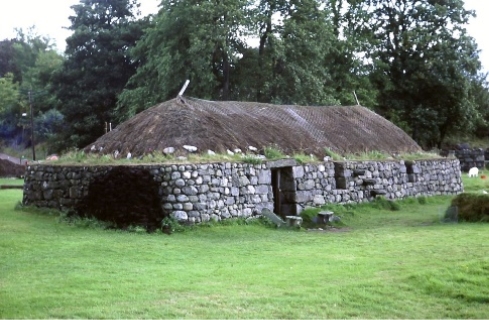 In Scotland and on the areas of west coast of wales, The stones are used to weighted the straw ropes that helps to keep the thatch on its place against heavy flow of wind and to protect the exteriors they frequently used lime or clay rendered.
In Scotland and on the areas of west coast of wales, The stones are used to weighted the straw ropes that helps to keep the thatch on its place against heavy flow of wind and to protect the exteriors they frequently used lime or clay rendered.
During the construction of house substantial quantity of materials are required for the construction and repair. In the earlier buildings it was uncommon for the timbers and masonry to be recycled. During the period of nineteenth century and twentieth centuries brought major changes to the transportation, allowing building materials to be carried over large distances at relatively small cost. Before when carts and rough tracks were the norm most of the buildings relied on materials obtained from the immediate locality. Mechanism and mass production changed the scenario it has boarded the supply and made the same building materials often at the expensive of local traditions. By late nineteenth century for example Economics of scale including new kiln technology made the builders for mass produced material and it became cheap and more easily available.it made a shift to large scale industrialised production and brought alteration in the pattern of building material use.Buildings long establishment as a professional occupation is shown in surnames such as carpenter, mason or Par getter. The building professional has always had its less reputable side, but the guild system within medieval towns and long apprentices for many crafts gave building high skill levels and status. Traditional building materials vary greatly across Britain. This variety reveals much about the underlying geology of localities and through the usage of materials in the building and these materials help illustrate the lives and inspirations of people from the past. The traditional building materials can be remarkably durable when it is properly maintained and in contrast with many modern alternatives that tend to weather and patinate beautifully so that their character is enhanced by age.


CHAPTER-3
TRADITIONAL MATERIALS – SCOTLAND
In Scotland stone is generally used to be the principle material for the buildings, but earth construction was predominant during the greater part of Scottish history. The use of earth as a building material, needs force to move heavy weights, it has a waterproofing agent in it, also used for decorative finish and even colouring agent, from the earliest settlement to the present day. The construction of major masonry structure like large chambered tomb at maes howe, orkeny is the result of using fine clay as a lubricant mortar to position the stones, Puddled clay is used as waterproofing agent round the stone structure. Mounded Earth to form an earth shelter and turf is used to enclosing bund. (Bruce Walker, 1996). The requirements of earth as a construction material are supposed to be compared with established standards that helps to determine their suitability for construction, few countries have formulated standards for the earth construction. Pise or rammed earth, cob, adobe are the four main traditional techniques broadly used and spread all over the world. Adobe, rammed earth and compressed Earth blocks are most wide spread earth construction techniques used today. The value changes significantly at the period of agricultural improvement and in industrialisation sector at the time of eighteenth and nineteenth centuries. Each and every earth building techniques depend on the biding agent. Each and every earth building technology depend on a binding agent, so that helps to hold the soil particles together and prevent slump to the soils natural angle of repose. Binding agent can occur naturally and combines with immense pressure can produce sandstone, shale and slate. The selection of materials is the most important, choosing the correct blend of binding agent and soil particles the earth builder can produce a building product does not require immense pressure to initiate binding but that has a superior wearing and structural qualities for the many of poorer quality sandstone that found in the central lowlands of Scotland. In Scotland traditionally used binding agent are fibre and clay, some of the materials like oils, lime, bitumen and cement can also be used , but these materials bring their own problem to the structure. The simplest way to use the earth for the building is to cut the material that is naturally reinforced with vegetable fibre
TRADITIONAL MATERIALS – SCOTLAND
List of SCOTLAND’S traditional materials are
STONE 
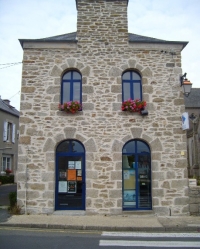
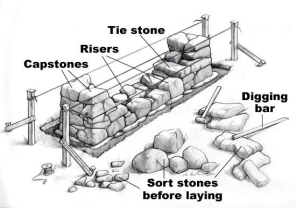 Scotland is a country rich in stone is also known as “land of stone “, over the centuries the material is used in wide variety of ways and produced many fine and functional buildings. When the stone is used with a proper understanding it is extremely flexible. There are many regional variations and wide variety of stone types, sensitive awareness and skill labours are required that creates a difference in construction and details have been produced through ages. The final appearance of any masonry build is determined by an integrated variation in stone- size by the economic use and choice of accessible material by the availability of craftsmanship skills and by established or developing working patterns.2 The secondary factors during the construction area the physical requirements of wall face and core bonding, the direct stone to stone point contact, day-work joints and the proper mixture of mortar (Ingval Maxwell, 1992).
Scotland is a country rich in stone is also known as “land of stone “, over the centuries the material is used in wide variety of ways and produced many fine and functional buildings. When the stone is used with a proper understanding it is extremely flexible. There are many regional variations and wide variety of stone types, sensitive awareness and skill labours are required that creates a difference in construction and details have been produced through ages. The final appearance of any masonry build is determined by an integrated variation in stone- size by the economic use and choice of accessible material by the availability of craftsmanship skills and by established or developing working patterns.2 The secondary factors during the construction area the physical requirements of wall face and core bonding, the direct stone to stone point contact, day-work joints and the proper mixture of mortar (Ingval Maxwell, 1992).
Dry stone build
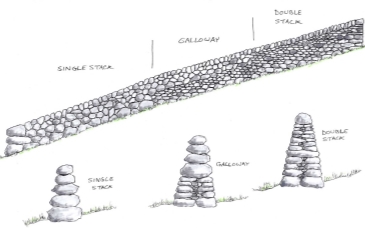 The predominant early mason builds were dry stone in construction with individual blocks being set without use of mortar. The greatest advantage is the skill of the craftsman particularly where the ready availability of regular, parallel side, slab material could be used. By the essential simple action of continuously forecasting the uppermost stone a fraction one over the one immediately below it. This is the scenario of emerging complex structures and architecture. (Ingval Maxwell, 1992)
The predominant early mason builds were dry stone in construction with individual blocks being set without use of mortar. The greatest advantage is the skill of the craftsman particularly where the ready availability of regular, parallel side, slab material could be used. By the essential simple action of continuously forecasting the uppermost stone a fraction one over the one immediately below it. This is the scenario of emerging complex structures and architecture. (Ingval Maxwell, 1992)
 Mostly these are free standing structures such as field walls, bridges and the buildings that build with irregular shaped stone, the stones are carefully selected and placed so that it fix tightly and closely together without any slip. It has wider base and become narrow when the height increases. The stone weight pushed inwards to support the structure and become stronger when any disturbance or settling occurs. The drystone structure are highly durable and easily repaired. These stones allow the water to drain through them, safe guarding the stone from damage. No special tools are required for this type of construction, only the skilled craftsman is needed for choosing and placing the stones (Jenifer Gray, March 2018).
Mostly these are free standing structures such as field walls, bridges and the buildings that build with irregular shaped stone, the stones are carefully selected and placed so that it fix tightly and closely together without any slip. It has wider base and become narrow when the height increases. The stone weight pushed inwards to support the structure and become stronger when any disturbance or settling occurs. The drystone structure are highly durable and easily repaired. These stones allow the water to drain through them, safe guarding the stone from damage. No special tools are required for this type of construction, only the skilled craftsman is needed for choosing and placing the stones (Jenifer Gray, March 2018).
[Grab your reader’s attention with a great quote from the document or use this space to emphasize a key point. To place this text box anywhere on the page, just drag it.]
Mortar build
By laying the stone, if the natural bed is said to be horizontal the structure emerging from is put together in a very balanced manner. It is especially important where the sandstones and sedimentary rocks are used. According to geological times the loose layering of materials which finally bonded to form such types of rocks were deposited in the position of horizontal manner naturally, this may found regularly in deserts or water. The stone which is formed in this style is better provided to carry imposed loads at right angles to its natural beds. Arches and corbels can be done best with these stones.
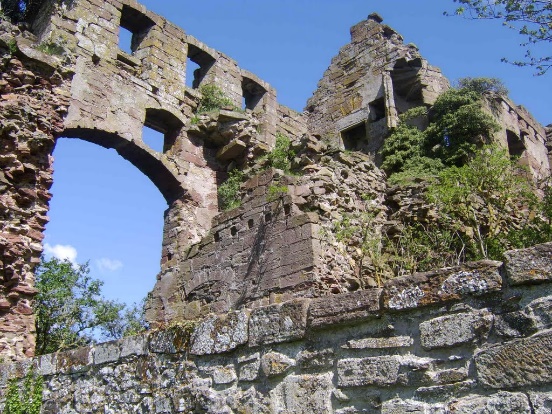
In some of the structures dealing with mortars not a dry stone there found a common appearance on the wall face of the construction. The close inspection shows the Direct Stone- to- Stone physical contact even though the mortar is present in it. Traditionally this provides flexibility in the construction. These constructions have wide variety of stones size in it.The last great masonry building work occurred in late 19th century, that is the period of time there is a change of style entered in to the building scene such as ‘politeness’ and refinement. This style expressed like all the faces of the stone to be cut square including the tails. This created a structure seems very rigid, hard, in band/out band profile which feels like it sat uneasily in a wall, providing a scene of traditional sense with irregular shaped rubble stone as an exposed face. This fixed that rubble should also be dressed square fit.
Based on the geological influence the stone used in the early construction of walls and dwellings used more of rounded field stones and boulders are the products of glaciation or gathered from the land or from the rived bed along the coast line. During 18th and 19th century ready source of boulders are used for the buildings of the fields drains, enclosures and march dykes. Local stones extracted from the rock out crops are not only used for the farm use and domestic buildings it also used for the large buildings like medieval castles has rubble built type of construction. Based on the geological factors the size of the stones are determined based on bed height and joining space on the original rocks creates a difference in the form of building.
Small dimensioned stones: Mainly constructed with small openings, it suits for defence purpose
Large stones: built purposefully for wide openings and could be extend over
Large blocks of stones: these are dressed stones, it is transported from other site used to build as lintels and corbels of windows and door openings.

In 19th C there are excess of working quarries for building stones and slates. Many buildings in major Scottish cities and towns are constructed using local stone and further material for roofing and paving. By the mid of 19thC Scottish cities started building with stones for prestigious buildings and houses as well, by the end of 19thC it became popular.
SLATE
“Scotch slate “the term implies the dark grey handsome slate from the quarries of west coast of Balachullish and Easdale, Argyll. The product from Caithness is heavier, richly browner, it has a reserved reputation for its appearance and durability. Indigenous slate quarries of the north east are less well known, especially these in Banffshire and Aberdeenshire. Providing good quality slates architects and builders completely utilized in 18th century and 19th century for roofing, kitchens, and large slabs for flooring and even in churches. ‘Slate Haugh’ is a place of slate worker cottages and the occasional place name .there was a very good slate quality at Melrose east of Macduff, the slates are good quality with beautiful blue colour but not lesser than Easdale slate it is thicker, larger and makes heaver roof. The high quality roofing slate is from north east from the mid of 18th to 19th century.
The current situation for slate is alike to the building stone. In the past few years material availability of slate has been improved and that once again reflects the Scottish slates. But there is no Scottish slate source of this material other than recycled material which is currently running out in high quantity. The indigenous is very high quality materials from specific courses and it should be used as ‘low carbon’, ‘high performance roofing material’.
LIME
In Scotland stone buildings are found in rich variety, majority of them are constructed using lime- mortared sandstone.” Lime” is one of the building material produce from burning of limestone and its subsequent ‘slaking’ with water aggregates can be combined and addition of water to produce plaster or mortar or it can used for lime washing when diluted with water. In the historic mortars of traditional building lime is was dominantly used as binding agent until the beginning of 20th century it was largely replaced by Portland cement. Lime is extremely flexible material for both finishes and construction. It became economically useful, well informed and skilled tradesperson. Lime mortars are very simple to prepare and use. It can be very durable and resilient when it is correctly used and properly maintained. In very old structure lime mortars are easily found even in 2000 years old structure, it is still effectively performing it function. The lime production for building mortars was primarily a local based activity. The lime in its natural slate it occurs in the form of limestone or as a form of calcium carbonate. The historic mortars has various characteristics in it, with the sources, the aggregate used and the method of burning the lime stone. Basic lime mortars have common characteristics they are easily workable, when it get cures it is permeable and soft that allows the structure to breath and retain their slight flexibility. Lime mortars are almost every time less durable than the stone they applied. The failure of lime mortars can also happens because of too rapid drying process. The method in which lime mortars cures involve the damp mortar absorbing carbon dioxide as it dries out, satisfactory mortar is not produced when the material is drying alone to avoid certain problems and difficulties in construction traditional simple lime mortars are modified by adding the pozzolanic material at certain point by incorporation of additional quantities of air into the mixture of mortar.
Other binders
Historically the materials available locally are selected for the buildings. Before the availability and widespread of lime they used earth and clay as binders in Scotland. The use of these traditional materials were replaced by lime and advanced to cement in modern construction.
Earth
The term “earth”, it refers the historic construction methods has material containing roots or/and vegetables fibre that provides 3dimensional mesh that binds the mortar together. Due to its ready availability and also the compatibility with relatively soft sandstones these type of mortars are primarily used.
Clay
Before the lime mortar became widely available in areas where there is no readily available lime stone for lime production wall are built either dry (without mortar named as ‘drystane’) or using clay or mud or mortar. In this 15th century replacing timber and tempered earth construction clay mortars were used in co-existence masonry were becoming common place. Mostly in basements and wall heads as a bonding agent clay was used because it acts as a waterproofing property, due to its vulnerability to moisture ingress. In 19th century clay mortars continued well in rural areas but lime mortar become cheaper and readily available and also common material in all types of construction.
Brick
During Roman occupation in 1st century AD brick was introduced to Scotland. Untill 17th century usage of bricks are largely died out, brick expanded on considerable palce in 18th century. in the later 18th century onset of the industrial revolution in the early 19th century the period of expansionof urbanaisation in Scotland, the brick become important and increasing buiding material. Urban areas like caltonin Glasgow and Granton in Edinburgh shows the extension use of brick in the housing construction for the increasing urban population. Many brick works constructed in areas where the traditional of building with clay or earth and the raw materials can be the same. Some of the early brick buildings built on footing of stone rubble and with wide thick wallswhich match those previously used for clay buildings.dnk
EARTH MATERIALS AS BUILDING PROCUREMENT
In this 21st century the earth construction projects are limited in the current market and clients with the high environmental awareness. The another potential market is based on appropriate repair and alteration for the surviving earth buildings, For the adoption of earth products it needs promotion and active marketing to spread wide and outside these sectors as well. In current scenario we have very few experts and designers in this field. The design opportunities should facilitate proper accepted standard, technical support and easy information to access. The earth materials are started importing or its produced based on the project need. Earthen architecture has an ability of demonstrating good relationship with the current buildings, this often involves substantial work for the designers and building control officials. Currently there is no proper standards for earth construction within U.K, but there is developing interest among the manufacturers to produce earth products instead of energy intensive products. The lack of documents is a significant measure on the development of earth construction. There are several ways to establish the standards and this should be promoted and create awareness from the established official organisation.
Cite This Work
To export a reference to this article please select a referencing stye below:
Related Services
View allDMCA / Removal Request
If you are the original writer of this dissertation and no longer wish to have your work published on the UKDiss.com website then please:



